|
The MBOW1 is an improved version of my first kit offering, the SPCA Special, and its successor, the MB1. It uses the similar but smoother GR Research M130 woofer rather than the Peerless SK0 130, and the superb Hiquphon OW1 tweeter instead of the TB1. I have implemented two crossover topologies for the MBOW1. The first is an acoustic second order Linkwitz-Riley crossed at about 2600 Hz. I have found that second order acoustic slopes provide a more cohesive blend between the drivers and produce a very clean, focused sound as long as the tweeter is up to the challenge. I had reservations about the OW1 due to its small size, but I have not been able to hear or measure any increased distortion in the lower highs. I have also provided a traditional fourth order Linkwitz-Riley that may prove more suitable if the speaker is used as part of a home theater system, perhaps with larger satellites (such as the 1801) that use fourth order slopes. In any event, the difference in sound is not great. But I do prefer the second order version.
The cabinet design is identical to the original MB1, with one small exception. The OW1 is smaller than the TB1, and the routing will have to be adjusted accordingly. The woofers are available from Danny Richie at GR Research, and the OW1 tweeters may be purchased from Zalytron or David Ellis. The crossover components should be widely available. I used good but not premium quality air core 16 Ga inductors. But if spending extra money on coils brightens your day, you may use 14 Ga for the two woofer coils. The M130 comes in both shielded and unshielded versions. They measure very similarly, and the choice is yours. Although the OW1 is not shielded, it should not cause problems if the cabinet is mounted vertically on top of a TV. If you wish to purchase finished cabinets with pre-drilled driver holes, they may be obtained from Delmond Won: delwon@verizon.net. These cabinets are about 4" taller than the plans show, and provide a compartment at the bottom to house the crossover. This approach is highly recommended in any event, since it's very difficult to squeeze all of those parts into the main interior space of the cabinet. Delmond does excellent work (he runs a large cabinet-making operation), and would be happy to discuss pricing for custom finishes with you.
The Crossovers
The first crossover is designed to provide 2nd order acoustic slopes over as broad a range as possible. Note that the tweeter is connected with reverse polarity, since its output is 180 degrees out of phase with the woofer at the crossover frequency. Also note that those little resistors (with a value of less than .5 Ohms) in front of the two woofer inductors don't really exist. The values simply indicate the DC resistance of the inductors themselves (but even those are approximate). The 6 Ohm resistor in line with that coil is very real, and provides critical shaping for the tweeter roll off. You should fine tune the high end response by experimenting a little with the tweeter L-pad values. If the sound is too bright for your room or tastes, try a 3 Ohm series resistor, and if that doesn't do it, reduce the parallel resistor to 8 Ohms. And don't overlook the 30 Ohm bypass resistor that is in parallel with the first woofer inductor. It's easy to forget, and doing so will mess up the response.
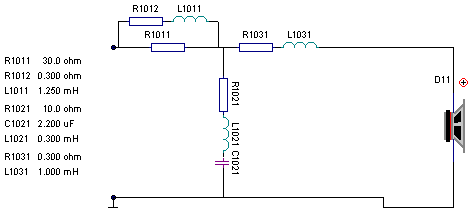
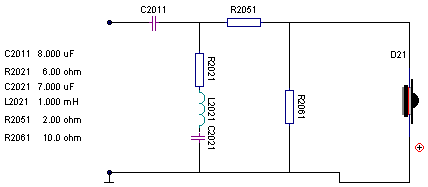
The cabinet used for these measurements had 3/4" roundover on all sides. This eliminated the diffraction problem that is apparent in the measurements for the 4th order crossover below. Here are unsmoothed Praxis plots of the on- and off-axis response.
On-Axis Response

15 Degrees Off Axis

45 Degrees Off Axis

Here is the response with the tweeter wired in direct polarity (180 degrees out of acoustic phase with the woofer). The steep reverse null shows the nominal crossover frequency of 2600 Hz and demonstrates that the slopes are true 2nd order acoustic in this region.
Reverse Null
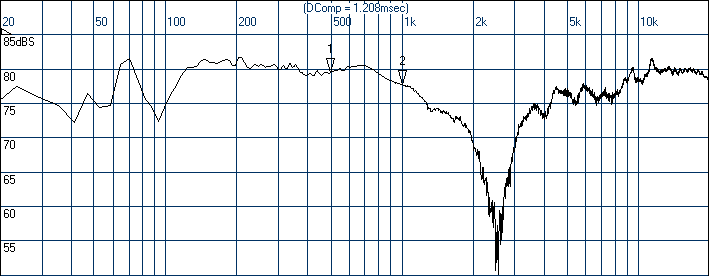
The second crossover is 4th order Linkwitz-Riley at about 2400 Hz. Note that the tweeter is wired in direct polarity with the woofer. Also note that the .5 Ohm resistor (one-half Ohm) in line with the .25 mH tweeter shunt coil really exists. The "resistors" in line with the two woofer series coils, however, are merely approximations of the DCR of the coils.
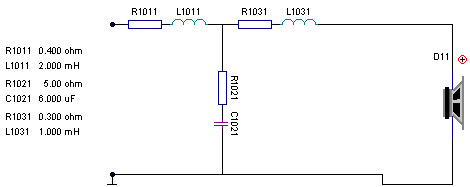
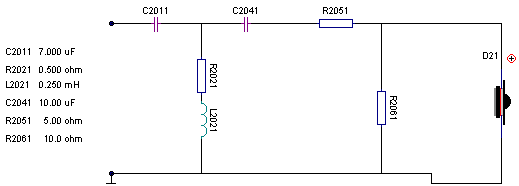
In this cabinet, the OW1 displays a pesky diffraction peak at around 4 kHz on axis (and a broader dip higher up). But notice that the peak disappears as you move even slightly off axis. Here are the corresponding Praxis measurements for the 4th order version:
On-Axis Response
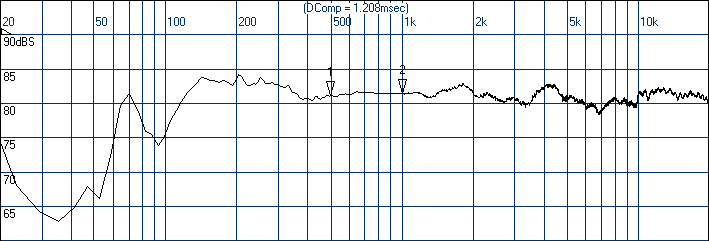
15 Degrees Off Axis

45 Degrees Off Axis
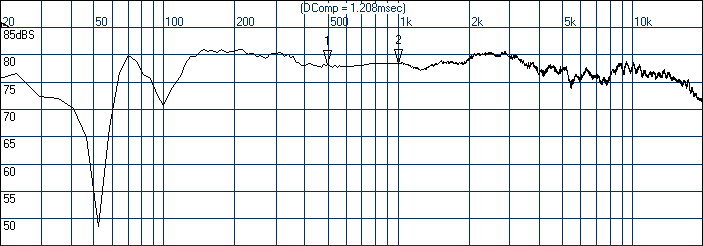
Reverse Null
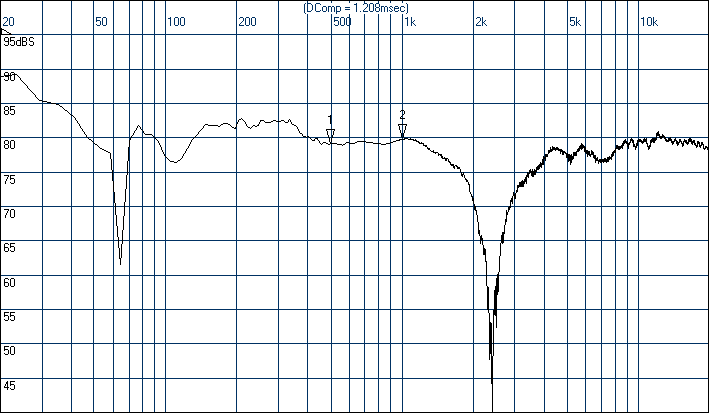
Cabinets
A complete set of plans can be found by clicking here. Don't forget that the tweeter routing shown is for the larger TB1 flange, not the OW1. So be sure to adjust accordingly. The smaller flange of the OW1 will allow you to move the woofer up slightly, which will free up a little valuable space for any protruding inductors on the crossover board. This page shows one possible layout for the crossover components. Here's another:
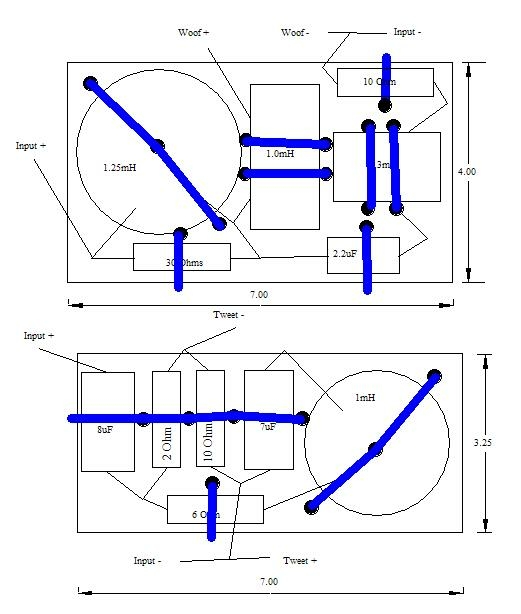
The cabinets will need some kind of sound treatment on the interior surfaces (other than the inside of the front baffle and the bottom, where the crossover will mount). BlackHole 5 is an excellent choice, although it will cost you about $50. Do not run the BlackHole all the way to the front baffle. Leave at least an inch bare so that it does not interfere with the woofer's backwave. Convoluted foam is a cheaper alternative. Under no circumstances should you add fill to the middle of the cabinet. This will destroy the box tuning, which is carefully chosen to extend bass below the 70 Hz limit you often encounter with 5" woofers. Bracing is optional and unnecessary with BlackHole. If you do brace, increase the interior volume slightly to compensate. I recommend adding a little length below the woofer. Finally, don't rabbet the woofer -- it surface-mounts over the tweeter. Rabbet the tweeter to the correct depth by eyeballing your router bit against the tweeter flange. You can check your work before cutting by first running the router down the edge of a piece of scrap. Remember to allow a tiny amount for the tweeter gasket.
You may also purchase finished cabinets from Danny Richie at GR Research. Just ask for the ones used for his AV1 kit. They are about 1" shorter than those specified in my plans, but this is not a significant problem.
Parts List for the Second Order Crossover
|
Two of each (except four 10 Ohm resistors):
- M130 shielded or unshielded woofer
- Hiquphon OW1 tweeter
- binding post
- port, 4" x 1-3/4"
- 8.0 uF cap
- 7.0 uF
- 2.2 uF
- 1.25 mH 14 or 16 Gauge inductor
- 1.0 mH 14 or 16 Gauge
- 1.0 mH 16 Gauge
- .30 mH 16 Gauge
- 30 Ohm resistor (to be wired in parallel with 1.25 mH inductor)
- 6 Ohm
- 2 Ohm
- 10 Ohm (4)
Finally, at least 12 big screws and 14 little screws. (Use black Phillips pan head, available from Madisound)
- 12 @ #8 x 1"
- 14 @ #6 x 3/4"
|
| 
